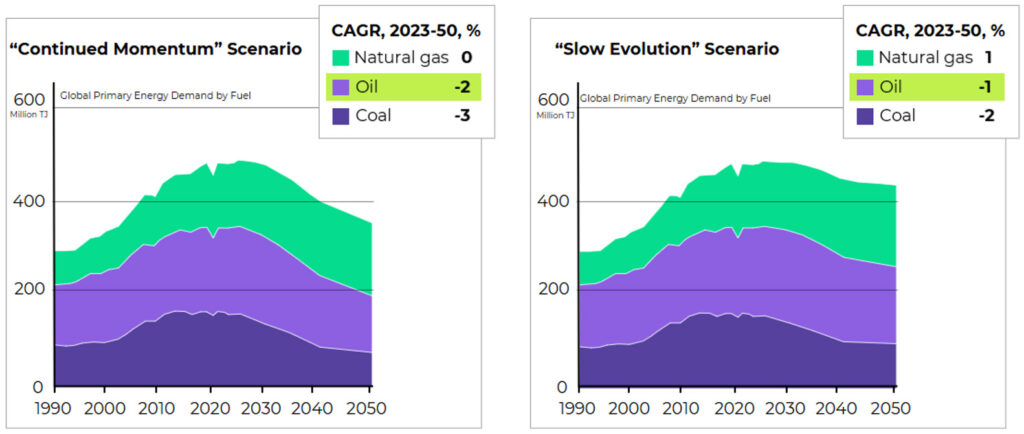
Maximizing Operational Efficiency with APIs and Automated Workflows
Featured in Convenience Store News: The Future of Fueling explores how leading fuel operators are leveraging technology to drive efficiency, reduce downtime, and future-proof their businesses.
According to the U.S. Energy Information Administration (EIA), gasoline demand in the U.S. has remained flat since 2022, with a projected long-term decline through 2026. Meanwhile, c-stores, which sell an estimated 80% of the fuel purchased in the U.S., saw total fuel revenues decrease 5.7% in 2024.
And the trend isn’t limited to the U.S. On a global scale, McKinsey’s Global Energy Perspective 2024 projects that oil demand will decline through 2050 at an average annual rate of 1-2%, depending on how quickly the energy transition plays out. Whether the scenario is “Continued Momentum” or “Slow Evolution,” fuel volumes are on a long-term downward slope.

Source: McKinsey Global Energy Perspective 2024
Today’s fuel operators are facing a clear but challenging reality: Volumes are flat, costs are up, and growth must come from within. And here’s how operators are doing just that.
In a market where pricing power is limited and wholesale swings are unpredictable; fuel efficiency is becoming a competitive advantage. Operators are turning to automation and real-time data to cut waste, increase visibility, and scale without adding complexity.
Across retail fuel operations inefficiencies show up everywhere:
When left unaddressed, they drivee up costs and erode the customer experience. But with the right platform in place, they become areas you can streamline with helpful insights, optimize, and turn into an advantage. Smarter fuel management helps operators improve in three core areas:
With automation and real-time data, operators can leverage fuel analytics to control avoidable losses like runouts, repetitive service calls, or compliance fines. This is made possible by automated systems that streamline supply and logistics, catch equipment issues early, and generate accurate compliance documentation.
One Titan Cloud customer experienced this first-hand when we helped them improve their ATG accuracy to optimize leak detection and BOL reconciliation. Integrating our platform, the fuel operator—who had recently grown to more than 500 sites—was able to reduce BOL reconciliation investigations by 50% and boost their delivery acceptance rate to 99%.
As retail fuel companies grow, they need to cover more ground—literally and figuratively. In the words of rapidly expanding Titan Cloud customer Chestnut Market, manual site check-ins had become unrealistic as they could only cover so much ground in a car, over the phone or by e-mail. For retail operators in growth mode, connectivity is a must.
Fuel asset optimization standardizes systems and processes so that additional sites can be seamlessly integrated as a company expands. Operators can use a centralized dashboard to monitor locations, manage deliveries with real-time scheduling tools, and expand site counts without adding unnecessary headcount.
Efficiency and speed go hand in hand, ultimately lowering operational costs. End-to-end transparency reveals data needed to make quick business decisions. Combined, speed and visibility enable faster system response times and an overall more efficient operation.
Case in point: In Titan Cloud’s 2025 Downstream Fuel Industry Report, 56% of midmarket retailers reported optimizing fuel inventory management to identify potential fuel loss quickly and reduce storage costs, while 25.3% said they use digital tools to streamline back-office operations and reconcile invoices faster. Additionally, instant alerts help teams pinpoint and prioritize critical issues quickly, complete compliance reporting in a fraction of the time, and reduce equipment downtime by flagging issues for predictive maintenance.
Fuel leaders who are making real progress are rethinking how their entire operation works, connecting the dots between supply and logistics, fuel analytics, maintenance, and compliance. They’re not waiting for demand to come back. They’re building businesses that can grow, adapt, and respond faster to whatever comes next.
This is exactly the kind of challenge Titan Cloud is built to solve. Our Fuel Asset Optimization platform brings automation, real-time data, and fuel analytics into one connected system, providing operators with a single source of truth to reduce waste and scale fast without adding complexity.
If you’re rethinking how your fuel operation runs, you’re in the right place. Explore the CSN News feature to see how Titan Cloud is helping operators scale smarter with a unified platform built for today’s fuel realities. Or reach out today to learn how we can help you drive speed, transparency, cost control, and scalability across your business.
